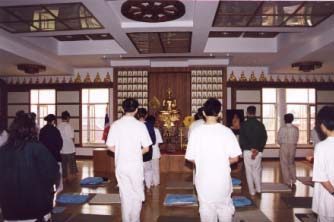How to practise
walking and sitting meditation
in the Buddhist Insight tradition (also called Vipassana)
Vipassana
is a Pali word which comes from the roots 'Vi' meaning 'clearly' and
'passana' meaning 'to know'. So it means
|
|---|
This is a simplified guide to the first of a series of 6 walking exercises.You are strongly advised to attend classes to get a real feel for this process. |
|---|
|
Be aware
of the position of the body standing. |
|
Move your point of attention
to the left foot. Be aware of the movement of the left foot as it is happening |
Continue walking, with awareness focused
on the movements of the feet until you come to the end of the walk
space. |
The practitioner should then
be aware of 'Standing' and 'Intending to walk' as before |
This walking exercise can
continue for about 15 minutes before you change to sitting meditation. |
Sitting
meditation |
Sit
in a stable position on a mat or large cushion on the floor or on a chair. |
Close your eyes and focus
the mind inwards. |
|
|


